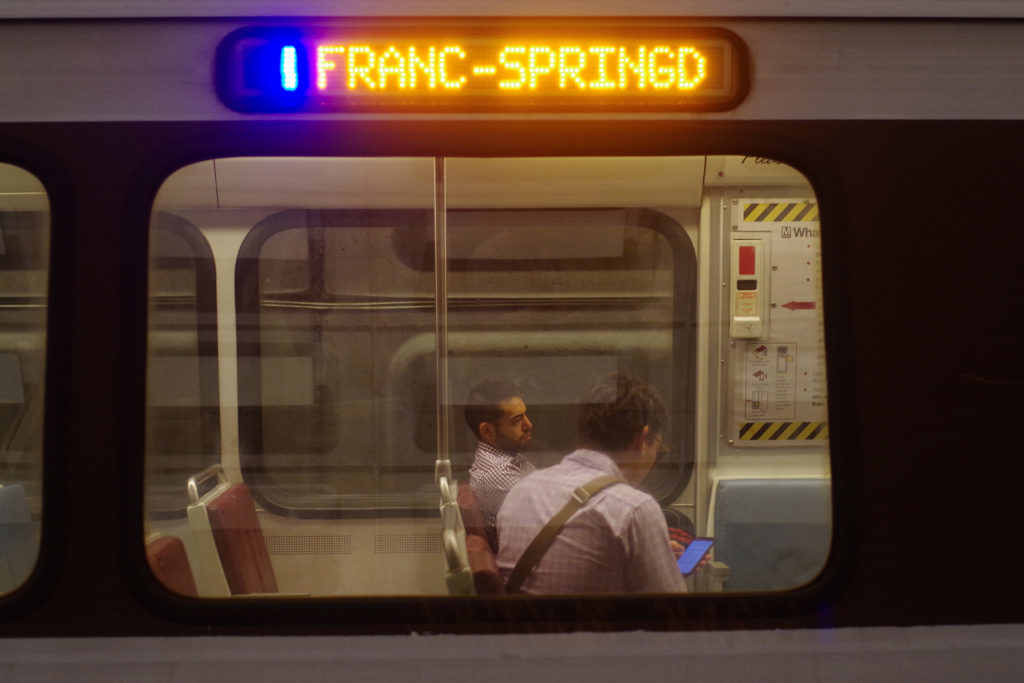After a summerlong partial shutdown for upgrades to six stations south of Reagan National Airport, the Metro line that Foggy Bottom residents depend on is up and running on schedule.
Six stations on the Blue and Yellow lines were shut down during June, July and August while the Washington Metropolitan Area Transit Authority added slip-resistant tile and LED lights to stations to create safer riding conditions. WMATA officials said working through the summer was less disruptive to riders because there are fewer people taking the lines during the summer months.
“We are incredibly thankful to our customers, residents and nearby businesses for their understanding this summer as we reconstructed six station platforms – at the same time – in the largest and most complex capital project since Metro’s original construction,” WMATA general manager Paul Wiedefield said in a release last week.
Six stations south of Reagan National Airport – Braddock Road, King Street-Old Town, Eisenhower Avenue, Huntington, Van Dorn Street and Franconia-Springfield – are now renovated with slip-resistant tile, LED lights and upgraded train status screens, the release states.
The stations now offer phone charging areas and an announcement system that is easier to hear, according to the release.
“When the project is complete this fall, customers will benefit not only from safer infrastructure but a more modern and convenient station experience,” Wiedefield said in the release.
Hewitt, the contractor that headed the renovations, is working for free to replace station signs the company wrote in the incorrect font, DCist reported last week. The station signs were printed in Helvetica Black but should have been printed in Helvetica Bold, according to DCist.
Ian Jannetta, a WMATA spokesman, said riders have not reported a noticeable change in ridership during the week the Blue Line ran again.
“While it’s too early to analyze ridership data, we know the majority of our riders stayed with Metro by taking advantage of free shuttle buses and regular Metrobus routes over the summer, so we do not anticipate a long-term negative impact on ridership,” Janetta said.
Riders who used the Metro line this summer said the partial shutdown added extra hours to their summer job or internship commutes, but they have not noticed major improvements since the line has reopened.
Mehrun Huda, a sophomore who commutes to campus from the King’s Street station – seven stops away from Foggy Bottom – said traveling to her on-campus job was difficult because taking the bus instead of the train added about 40 minutes to her commute. She said the shuttle busses often arrived late, and her dad would drop her off at the Pentagon City station, where she would take the Metro to Foggy Bottom.
“It was a really frustrating experience, especially with the shuttle buses, because sometimes I didn’t know if there was a schedule when they would come,” Huda said.
She said her commute is easier now because she can skip the bus ride and take a shorter trip to campus. Huda said that while WMATA’s adjustments to the line made the trains look “cleaner,” they have not affected her daily commute.
Stefanos Psaltis-Ivano, a Metro rider who commutes from Alexandria, Va. to Dupont Circle for work, said the shutdown added about 30 minutes to his usually 50-minute ride. He said he has noticed improvements to his station’s platform, namely repainted concrete that was falling apart before renovations.
“I can definitely tell before, when I was taking the Metro, the stations were near crumbling,” he said.
Taylor Young, a sophomore who stayed on campus this summer to work as a canvasser for an advocacy organization, said the Blue Line shutdown added about an hour to her regularly 30-minute trip to canvas in areas south of Reagan National Airport.
She said commuting to stations south of the airport again has helped her canvassing team get to and from their five-hour shifts within 30 minutes.
“Old Town Alexandria is a great place to canvas,” she said. “Now we can get there within the hours that a lot of people are on the streets and that will increase the donations that we get.”
Zoya Wazir contributed reporting.



